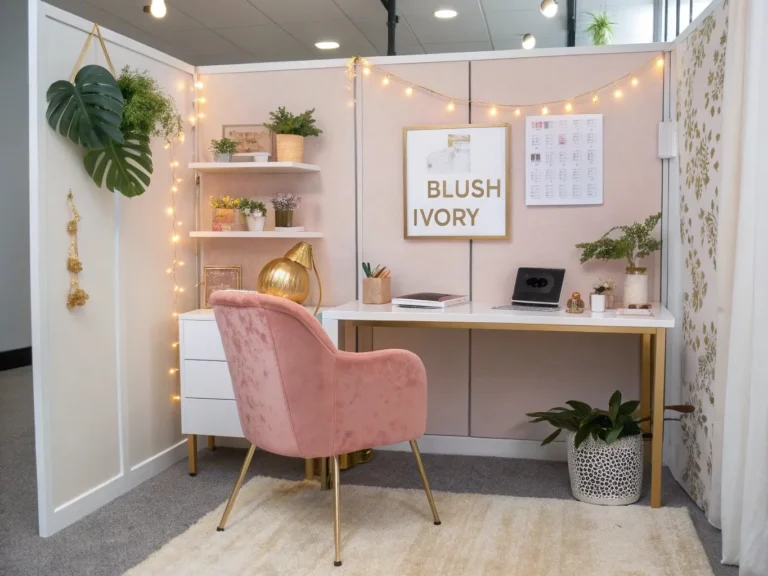12 Serene Japanese Living Room Ideas That Embrace Minimalism and Zen
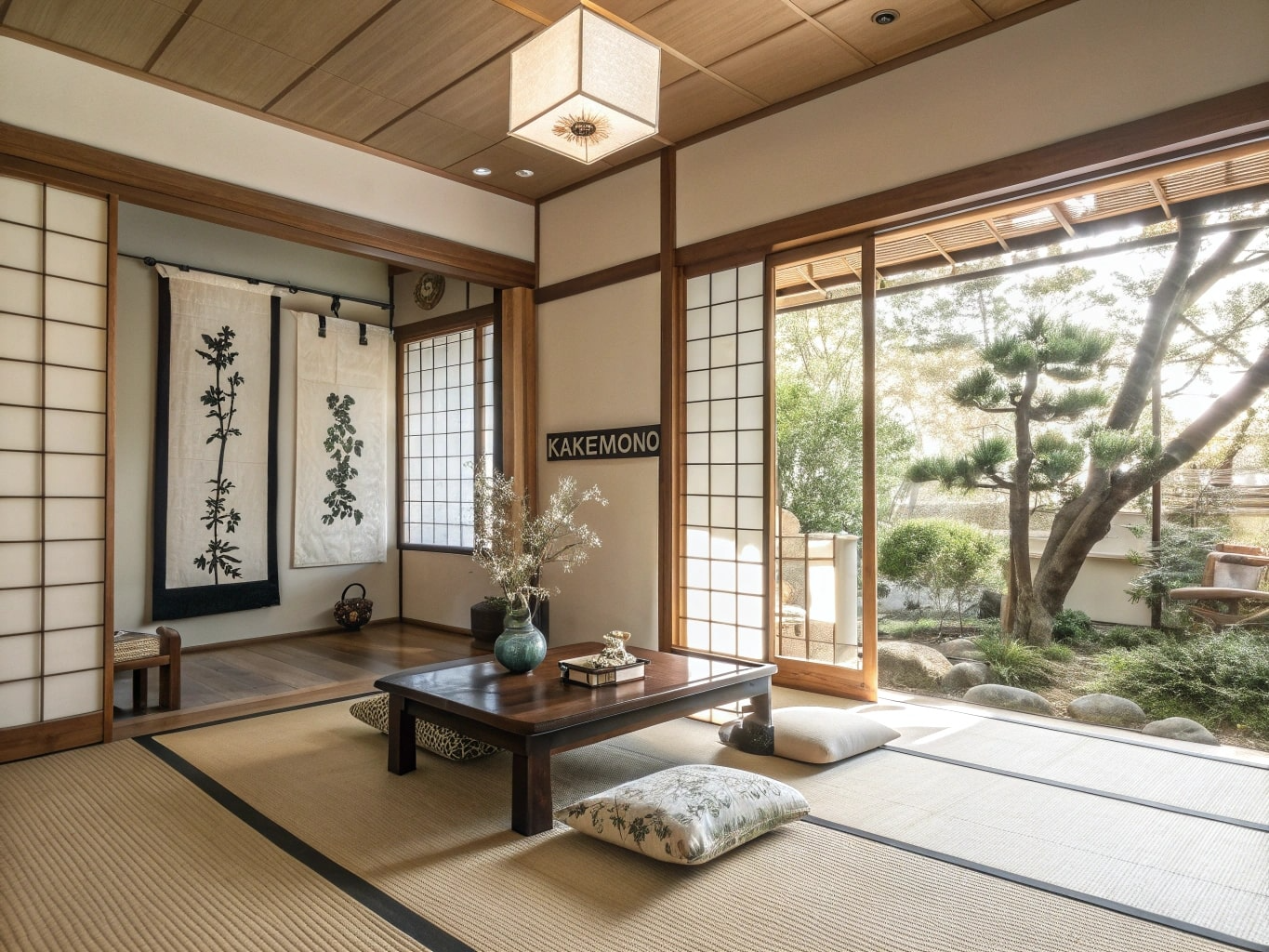
Creating a serene, Zen-inspired living room is about embracing simplicity, nature, and mindfulness. Incorporating elements of traditional Japanese design can help turn your space into a tranquil retreat that promotes relaxation and calmness. Here are 12 ideas that will help you design the perfect Japanese-style living room with minimalism and Zen at its heart.
Tatami Mats and Floor Seating
Tatami mats are an essential element of Japanese living rooms, providing a soft, natural surface for sitting and lying down. These woven straw mats create a sense of groundedness and offer a traditional touch to the room. By using tatami mats instead of a rug, you instantly introduce an authentic Japanese feel. Pair them with low wooden furniture or cushions for seating to create an open, functional, and comfortable space.

Floor seating is an integral part of Japanese interiors. It encourages a close connection to the earth, promoting mindfulness and relaxation. Using zabuton cushions around a low wooden table allows you to fully embrace this minimalist seating arrangement. The simplicity of floor seating, combined with tatami mats, makes the space feel uncluttered and peaceful, ideal for meditation or casual conversations.
Shoji Screens and Sliding Doors
Shoji screens are a quintessential feature in Japanese homes, typically made of wooden frames and translucent rice paper. These screens allow natural light to filter through while maintaining privacy, creating a soft, diffused glow that enhances the peaceful atmosphere of your living room. Shoji screens can be used to divide spaces or as window coverings, offering both functionality and aesthetic appeal.
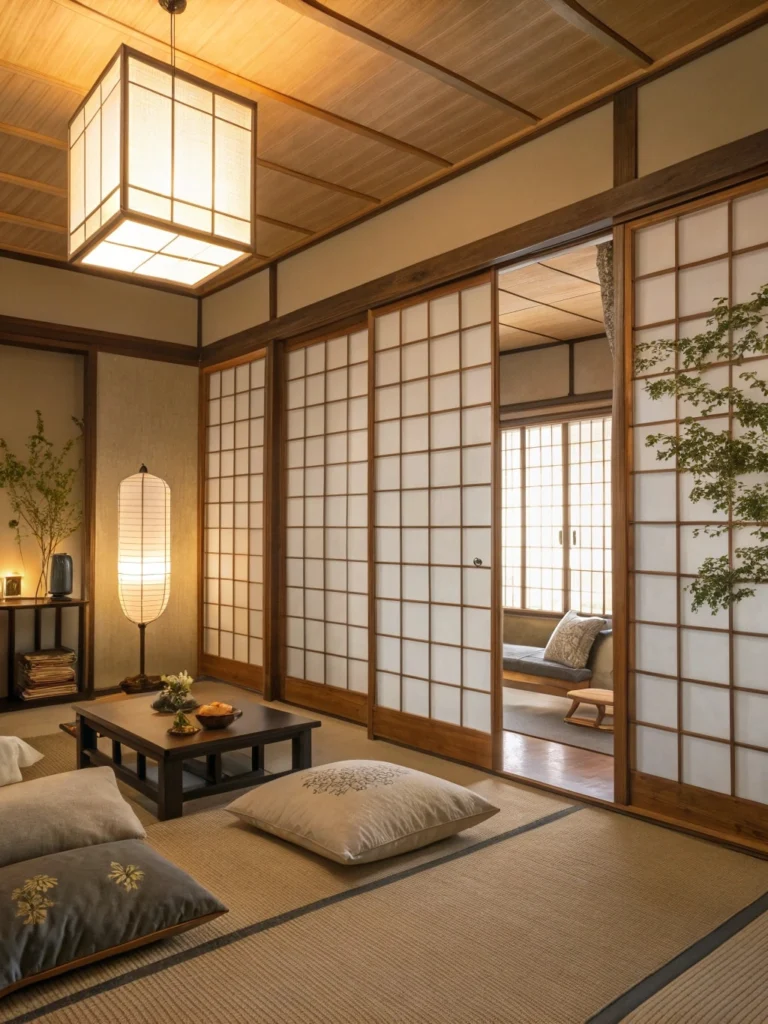
Sliding doors, a signature of Japanese design, are ideal for maximizing space and promoting an open, fluid layout. These doors eliminate the need for traditional swinging doors, which can take up valuable space in smaller rooms. Whether you choose wooden sliding doors or modern versions with glass panels, these doors help maintain the minimalist feel of the room while allowing for flexibility and privacy.
Natural Wood Accents
Wood is a central element in Japanese design, offering warmth and a connection to nature. Wooden furniture, such as low wooden tables, bookshelves, and storage units, adds an organic feel to the space. The simplicity and elegance of natural wood, especially when left unfinished or lightly treated, contribute to a minimalist aesthetic that evokes tranquility and harmony in your living room.
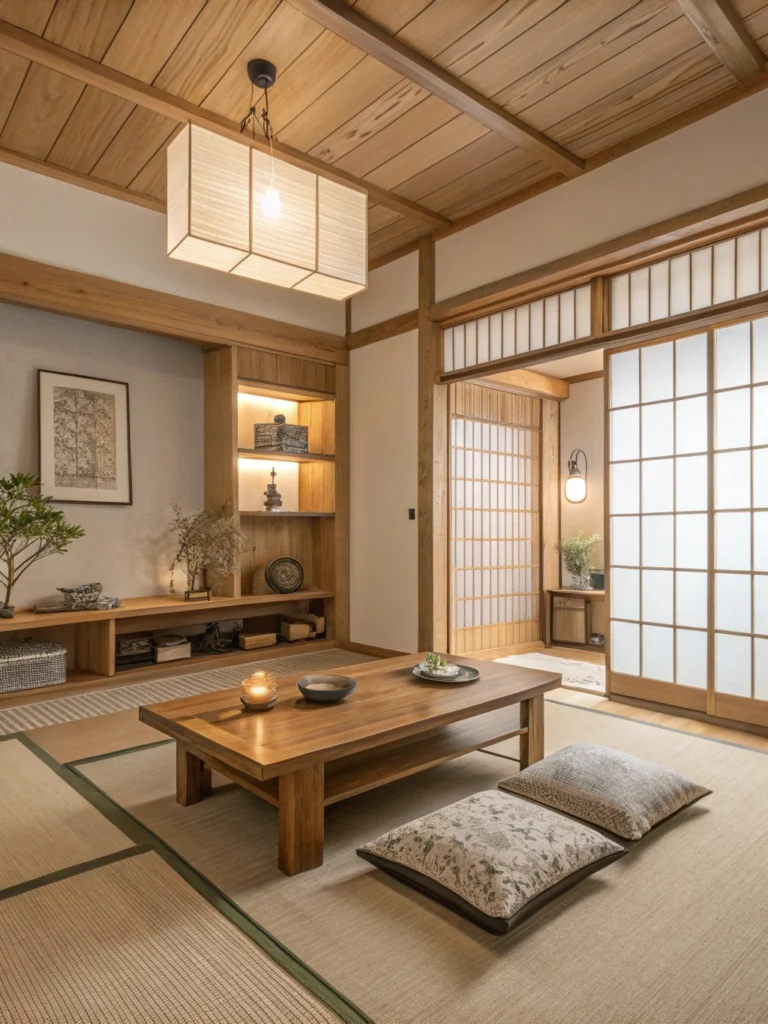
Wooden flooring is another key feature in Japanese-inspired interiors. It helps create a grounded atmosphere while enhancing the natural beauty of the room. Light or medium-toned wooden floors complement other natural materials, such as bamboo and stone, and add warmth without overwhelming the space. The beauty of wood lies in its natural variations, making each piece unique and bringing a touch of nature into your home.
Neutral and Earthy Color Palettes
A neutral and earthy color palette is essential in a Japanese-inspired living room. Soft shades like beige, ivory, and muted greens create a calming environment, perfect for relaxation and focus. These colors evoke a sense of nature, helping to reduce stress and create a peaceful atmosphere. A neutral palette serves as a backdrop for other natural materials, like wood and stone, which complete the Zen-inspired look.
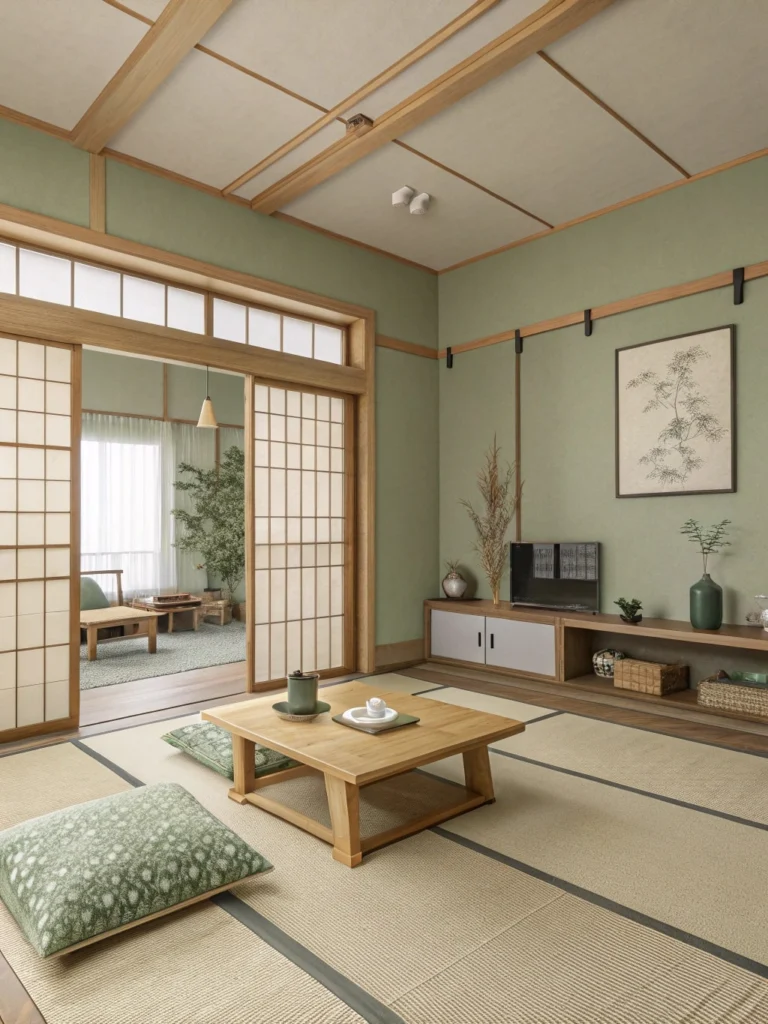
Earthy tones, such as terracotta, taupe, and moss green, can be incorporated as accent colors to add depth and warmth to the room. These hues blend harmoniously with neutral tones and natural textures, enhancing the room’s organic feel. Earthy accents, like throw pillows, rugs, or wall art, bring a natural vibrancy to the space while maintaining a serene and harmonious ambiance.
Minimalist Furniture Designs
The heart of Japanese furniture design lies in simplicity. Low-profile furniture, such as wooden benches, low sofas, and simple tables, embrace the Japanese philosophy of reducing excess. These pieces are often made from natural materials and emphasize function over ornamentation. The simplicity of the furniture allows for easy movement and creates an open, uncluttered space, perfect for a peaceful living environment.

When selecting furniture, focus on clean lines and understated elegance. Avoid heavy, ornate pieces, and opt for functional, space-saving options instead. Consider adding multifunctional furniture, such as storage benches or folding tables, to ensure your living room remains organized and practical while maintaining its minimalist charm. The key is to balance beauty with purpose and create a room that feels spacious and serene.
Indoor Plants and Bonsai Trees
Indoor plants, like bamboo, ferns, and peace lilies, are essential for creating a natural, Zen-inspired living room. Not only do they improve air quality, but they also bring life and vibrancy to the space. Indoor plants are an easy way to add a touch of nature to your home while promoting a sense of calm and balance. Ferns and bamboo are particularly popular for their symbolic connection to growth and peace.
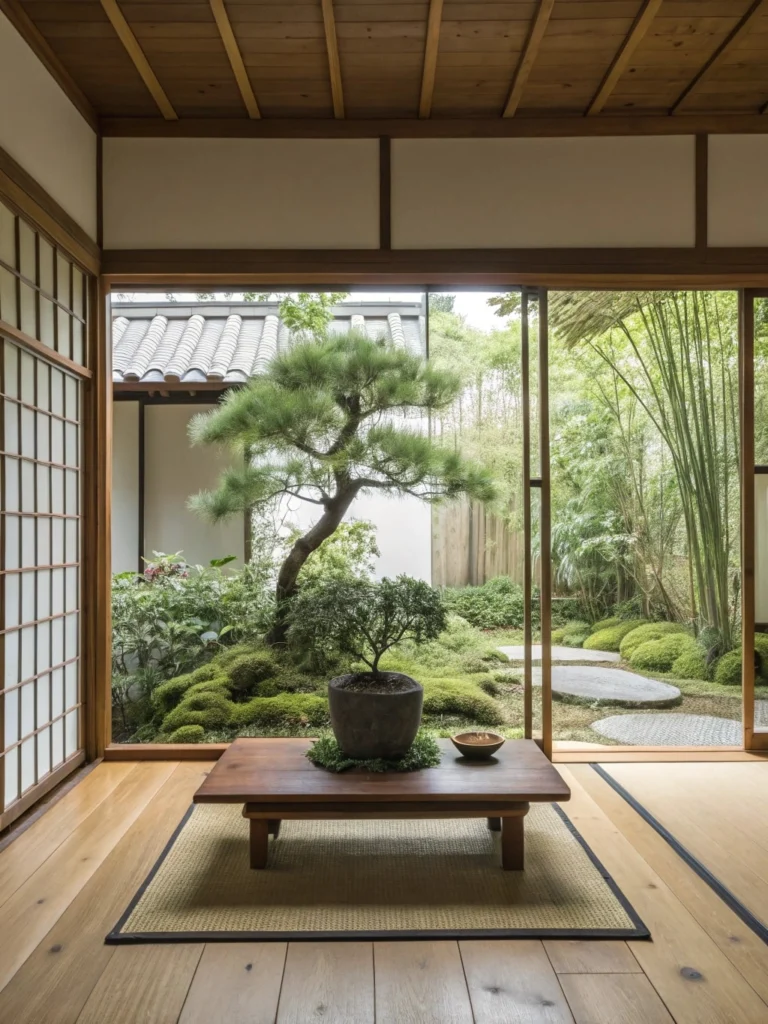
Bonsai trees are another key feature in Japanese living rooms. These miniature trees symbolize patience, balance, and harmony. With their intricate forms and sculpted appearance, bonsai trees serve as a beautiful focal point, adding both beauty and tranquility to your space. Whether placed on a low table or shelf, they contribute to the Zen-inspired atmosphere of the room.
Soft, Ambient Lighting
Lighting plays a crucial role in creating a peaceful, Zen-inspired atmosphere. Natural light is ideal, so place your living room near a window that lets in sunlight. If possible, incorporate sliding doors or larger windows to enhance the flow of light throughout the day. In the evening, use soft, warm lamps, paper lanterns, or candles to create a relaxing ambiance that complements your yoga or meditation practice.

Dimmer switches are also a great addition, as they allow you to adjust the lighting to your mood and time of day. Using subtle lighting such as pendant lights, sconces, or LED strips can add a gentle glow to the room. This type of ambient lighting enhances the calming atmosphere, making the room perfect for quiet moments of reflection or relaxation.
Zen-Inspired Decorative Elements
Zen-inspired decorative elements focus on simplicity, nature, and mindfulness. Incorporate stone sculptures, wooden trays, and ceramics into your living room to add subtle texture and elegance. These elements should complement the minimalist decor, contributing to the overall peaceful vibe of the room. Keep the decor simple, avoiding excessive or overly ornate pieces, and instead, choose items that align with your Zen philosophy.
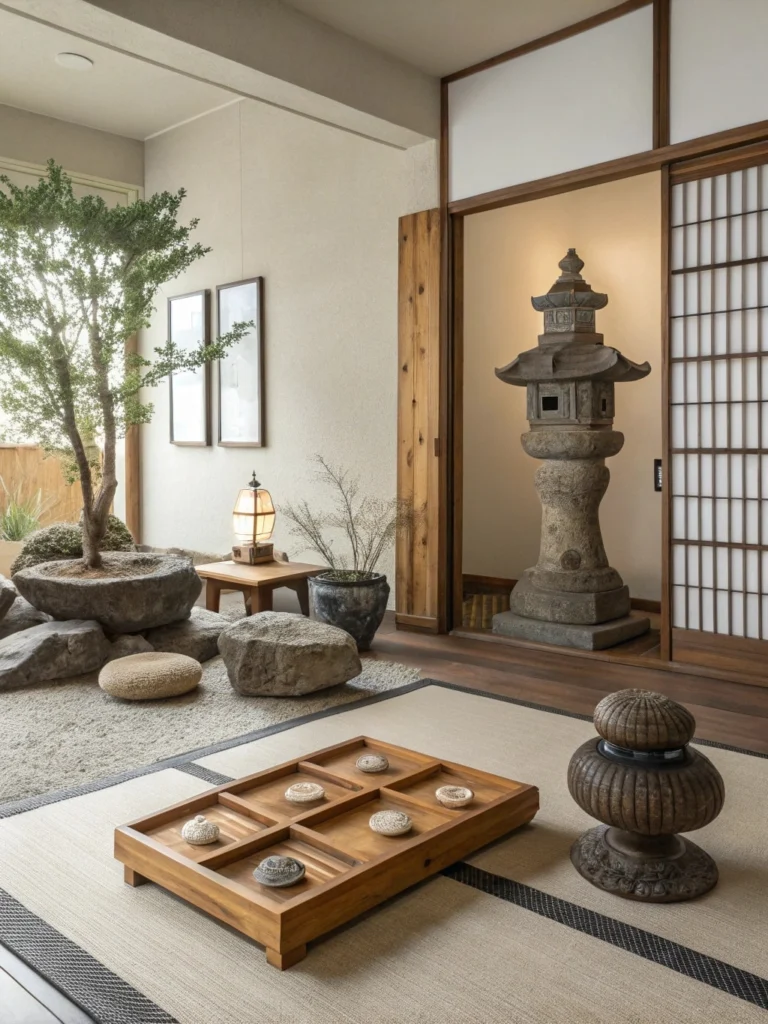
In addition to functional decor, adding Zen-inspired artwork or symbols like mandalas, Zen calligraphy, or abstract art can bring spiritual depth and meaning to the space. Such decor not only enhances the room’s aesthetic but also serves as a reminder of mindfulness and balance.
Open and Airy Layouts
An open and airy layout is central to creating a Zen-inspired living room. In Japanese interiors, the emphasis is on creating a sense of space and flow. The arrangement of furniture should allow for unobstructed movement, making the room feel expansive and peaceful. Avoid overcrowding the room with too many pieces of furniture or decor. Instead, focus on a few carefully chosen elements that maintain harmony and balance.
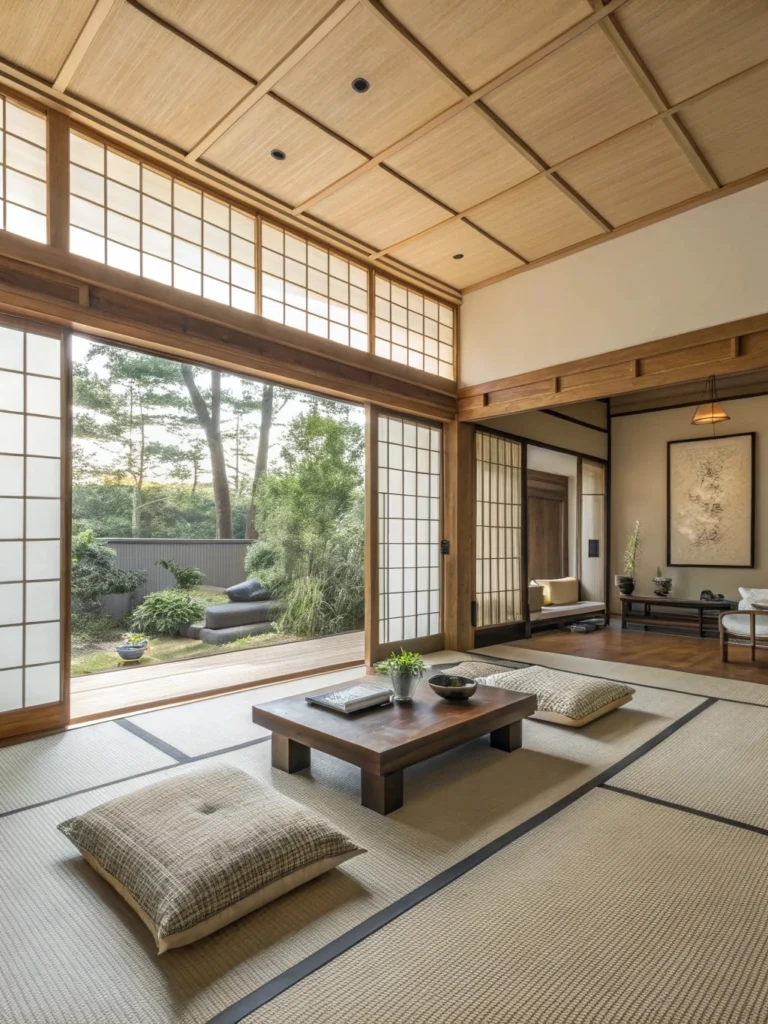
The design of a Japanese living room prioritizes spaciousness. Open floor plans, high ceilings, and minimalist furniture contribute to an uncluttered feel. This layout promotes relaxation and mindfulness, creating a space where you can move freely and embrace tranquility. By keeping the room open and fluid, you encourage a calm, meditative atmosphere.
Traditional Art and Wall Scrolls
Traditional Japanese art, such as woodblock prints or ink paintings, adds cultural depth and serenity to your living room. These art pieces often depict nature, animals, or peaceful landscapes, enhancing the Zen aesthetic. Choose artwork that complements the room’s color palette and Zen-inspired theme. Traditional art adds a layer of calmness and enhances the overall ambiance, promoting mindfulness and focus.

Japanese wall scrolls, often depicting landscapes or Zen symbols, are another excellent way to enhance your living room. These scrolls offer an elegant and minimalistic approach to wall art. Hanging scrolls can become a focal point of the room, offering spiritual depth and a constant reminder of your connection to nature and mindfulness.
Wabi-Sabi Touches
Wabi-Sabi celebrates the beauty of imperfection and the natural aging process. Incorporating Wabi-Sabi touches into your living room helps you embrace simplicity and authenticity. Items like weathered wooden furniture, handmade pottery, and uneven stones reflect the beauty of imperfection, contributing to a warm, welcoming space. These pieces add character and depth, allowing you to appreciate the beauty in the natural cycle of life.
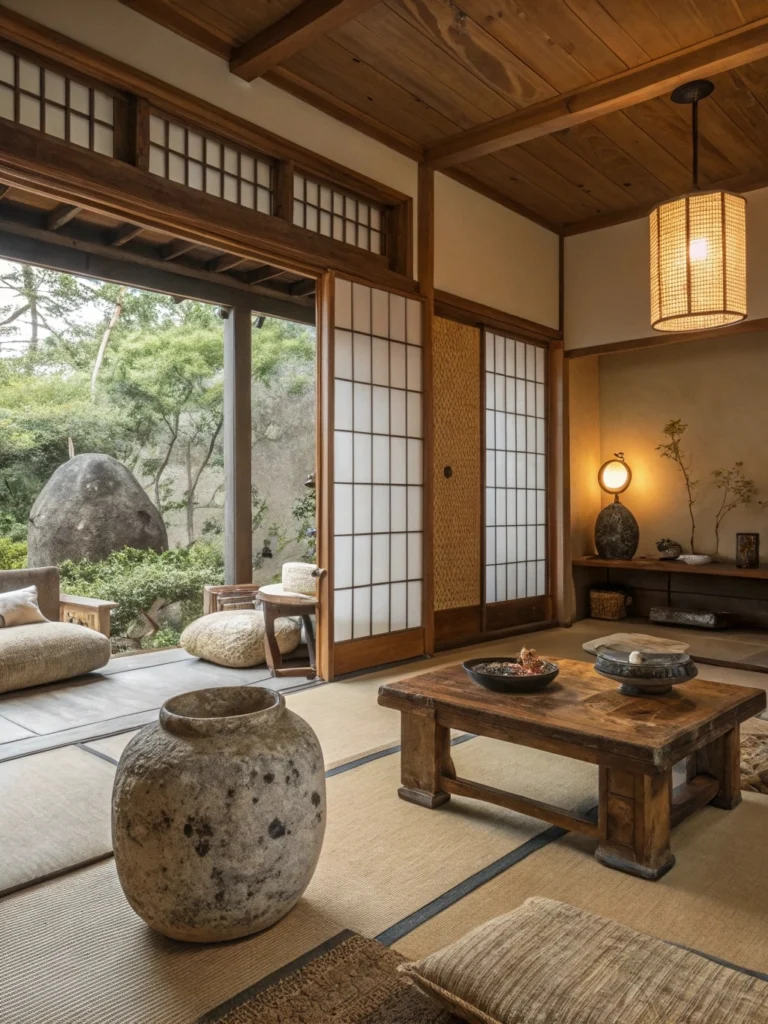
Wabi-Sabi also encourages mindfulness and acceptance. The imperfections in these objects serve as a reminder to be present and to embrace the beauty of the moment. Incorporating Wabi-Sabi elements into your decor adds a layer of authenticity and calmness, helping you connect with the true essence of Zen living.
Meditation or Tea Corners
Creating a meditation or tea corner in your living room allows you to dedicate space for relaxation and mindfulness. Use floor cushions, a low wooden table, and calming decor to create a peaceful corner for meditation or tea ceremonies. This space should be free from distractions and designed to encourage moments of stillness, reflection, and contemplation.
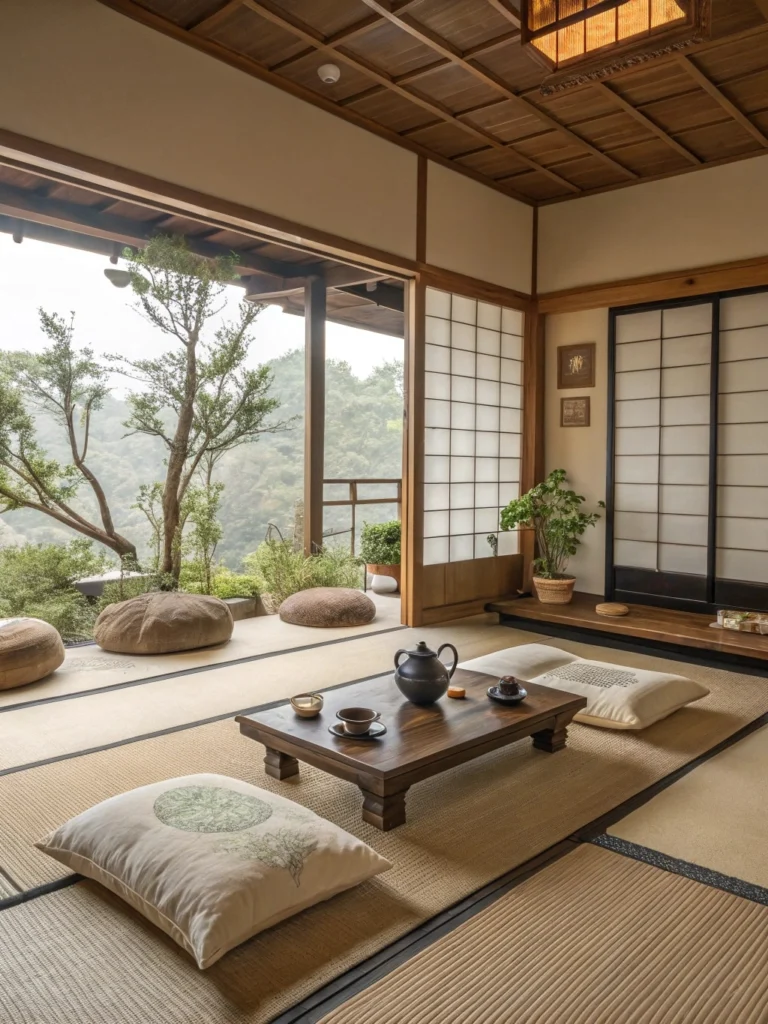
Incorporating elements of the Japanese tea ceremony, such as a tea set, bamboo tray, and simple accessories, enhances the ritualistic aspect of the space. These elements promote slow living and mindfulness, allowing you to take time out of your day for reflection and inner peace.
Conclusion
Designing a Zen-inspired Japanese living room is about embracing simplicity, nature, and mindfulness. Incorporating elements like tatami mats, shoji screens, and natural wood accents can transform your space into a peaceful retreat that promotes relaxation and calmness. By focusing on minimalism, functionality, and authenticity, you can create a living room that fosters tranquility and enhances your overall well-being.
FAQs
1. What is the best color palette for a Japanese-inspired living room?
Soft, neutral, and earthy tones such as beige, ivory, sage green, and light brown are ideal for creating a Zen-inspired atmosphere. These colors promote relaxation and a connection to nature.
2. How can I incorporate Zen elements into my living room design?
Focus on simplicity, natural materials, and minimalism. Incorporate items like tatami mats, wood accents, bonsai trees, and Zen-inspired artwork to create a peaceful, balanced environment.
3. What is Wabi-Sabi and how does it fit into Japanese decor?
Wabi-Sabi celebrates the beauty of imperfection. It embraces natural wear, rustic furniture, and handmade items, adding authenticity and character to the space.
4. Can I create a Japanese-inspired living room in a small space?
Yes! Focus on minimalistic furniture, light colors, and multifunctional storage. Keep the space clutter-free and create an open layout to maximize the sense of serenity and space.
5. How do I maintain a Zen atmosphere in my living room?
Regularly declutter and clean your space, and keep the decor simple. Use calming scents, such as incense or essential oils, and create a dedicated space for mindfulness practices like meditation or tea.






